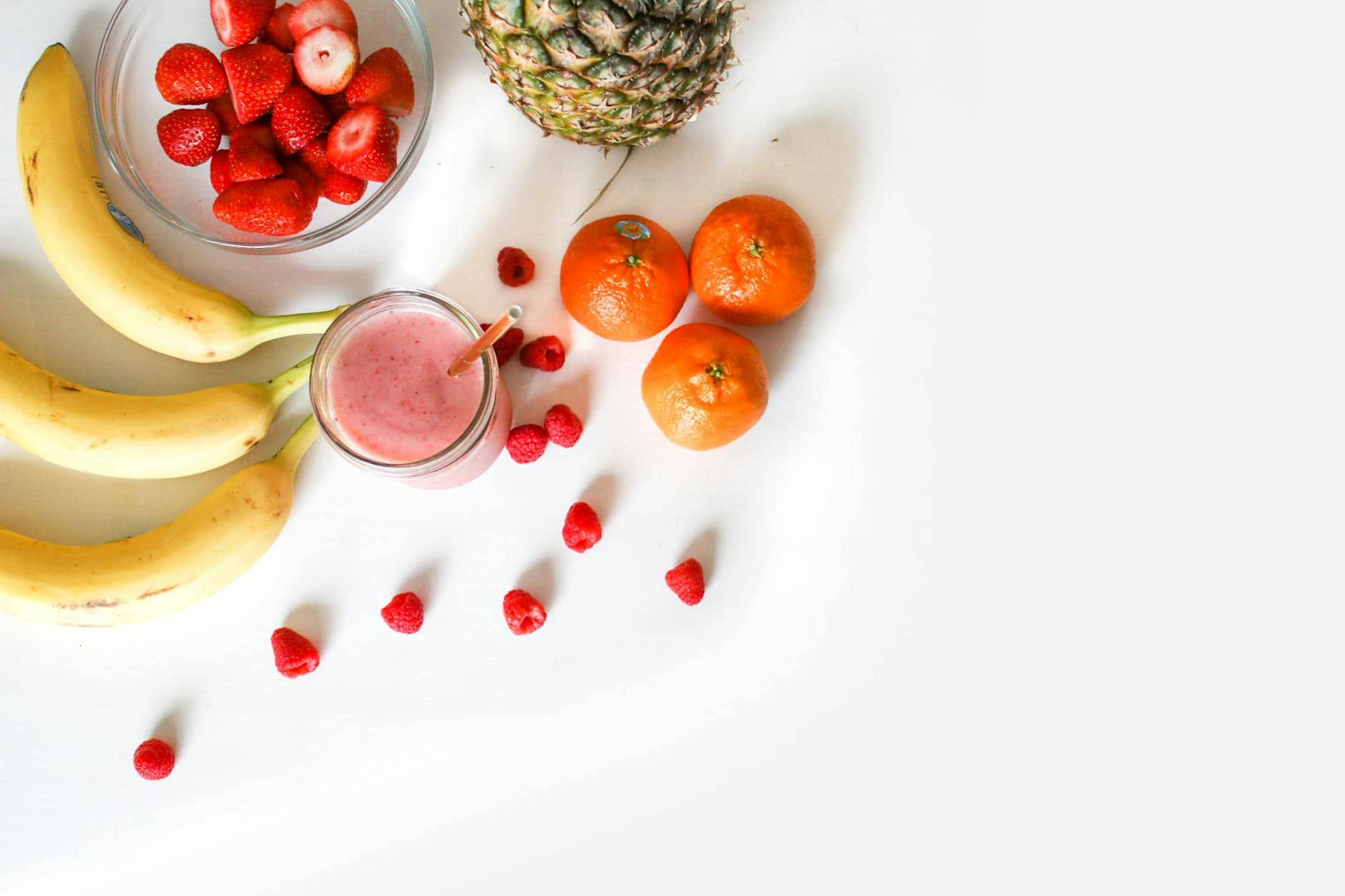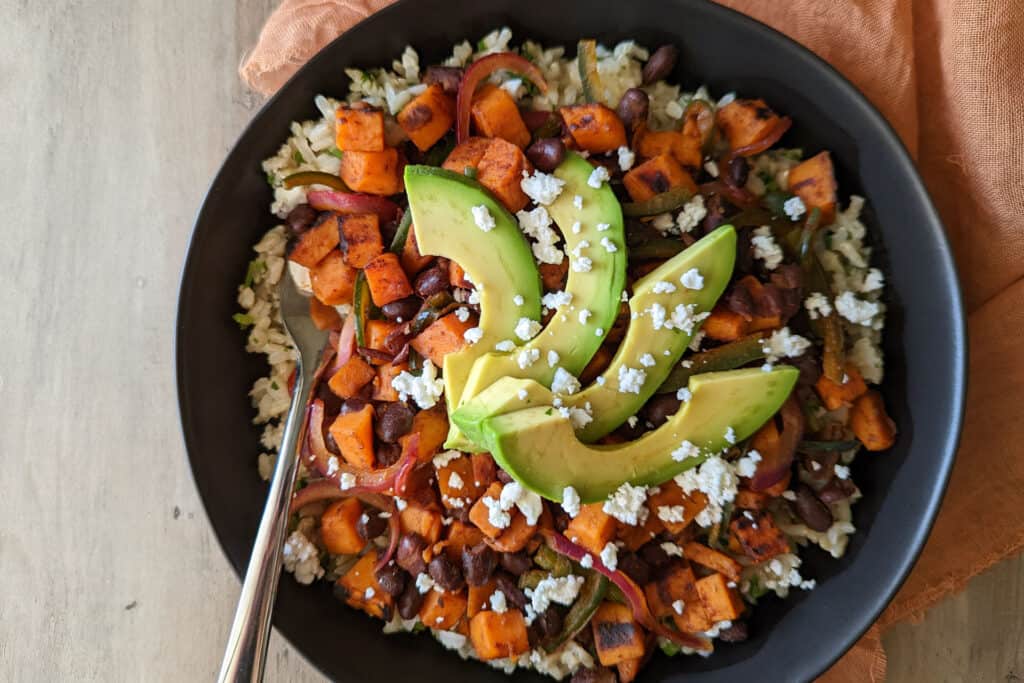How To Eat Healthy On A Budget
This post may contain affiliate links. As Amazon Associates and through other affiliate programs, we earn from qualifying purchases if you click on a link – at no extra cost to you. We only promote products we actually use and truly love!
The rules we follow every week to help you figure out how to eat healthy on a budget, no matter what “healthy” means to you.
How to eat healthy on a budget: isn’t that the question we all ask ourselves every year come January?
It’s a classic New Year’s Resolution – and one we try our best to stick to throughout the year – as we come off the high of overindulging and overspending during the holidays.
But it’s also a bit of a conundrum, since we don’t often equate healthy foods with shopping on a budget. Well, we’re here to bust the myth that you can’t eat healthy on a budget, armed with tips for how we approach this balancing act every week.
When we think about eating healthy on a budget, 5 “rules” come to mind based on our experience:
- Define what “healthy” means to you
- Shop smart
- Cook at home
- Keep a well stocked pantry
- Meal plan
We’ll go into detail about how we use each one of these guidelines for ourselves, and help explain how they might be useful for you.
Finally, we’re going to share what a typical “healthy” week looks like for us shopping on a budget for two – what we buy at the grocery store and what meals we like to cook. Hopefully, this can be an inspiration for you and a starting point to help you kickstart your wellness journey!

Rule #1: Define What “Healthy” Means To You
Before you begin your healthy eating journey, stop and ask yourself: what does “healthy” mean to me? Checking in on your own definition of healthy can help you more clearly define your goal, which will make it much easier to stick with any plans you make.
To us, “healthy” is a fairly subjective word, and can be defined in many ways depending on your goals. This can look like a few different things, including (but not limited to):
- Eating more fruits and vegetables
- Cooking at home more often instead of dining out or getting takeout
- Reducing the number of times you eat fast food per week
- Getting better at portion control
- Creating a more balanced diet
- Eating a more wholesome diet without processed foods
So take a few minutes to figure out what your definition of “healthy” is before reading on. No matter what you decide you want to focus on this year, our rules for eating healthy on a budget are universal and will help you achieve success on your wellness journey!

Rule #2: Shop Smart
This one might seem obvious, but the first place to start when you want to eat healthy on a budget is the grocery store. Home cooked meals are almost always more affordable than eating at restaurants or getting takeout, and you don’t have to spend big bucks to walk away with wholesome, unprocessed ingredients in your shopping cart.
Start by making the switch from processed and pre-made ingredients to more fresh produce and raw ingredients. Things like rice and beans, pasta, and all your favorite fruits and veggies. It might be hard to skip over the junk food aisle and forgo your favorite chips, but snacking on some carrots or grapes instead of a $6 bag of Cheetos will help you save money and achieve your healthy eating goals.
When we made the switch to buying more fresh produce and cooking from scratch, we saw a huge difference in our grocery bill. A cart full of vegetables costs a fraction of what you might be used to paying for ready-made meals and instant packs of mac and cheese.
Remember that this doesn’t all have to happen at once. Next time you go to the grocery store, start your shopping in the produce section, then move on to proteins and grains, and save the processed foods aisles for last. Over time, you may find yourself filling up your cart with whole foods and choosing to forgo processed ingredients and snacks to save money.
And, as always, be on the lookout for sales and coupons! Many grocery stores now have mobile apps that let you browse and claim deals ahead of your shopping trip so that you automatically save money at checkout. Research the stores you typically shop at and make sure to sign up for any rewards programs they might offer as well.

Rule #3: Cook At Home
Like we said, home cooked meals are almost always more affordable than eating out. And the more you learn to cook at home, the more confident you’ll become, and the more you’ll likely want to keep cooking at home (it’s a cycle we know all too well at this point!).
Now, you don’t have to become a masterful scratch cook to save money by cooking at home. But if you want to challenge yourself, there is a huge benefit to cooking as much as you can from scratch – both from a health standpoint and a budget standpoint.
Case in point: Alex has been experimenting with making bread from scratch over the past few months. To make one loaf of delicious crusty white bread, he uses about 3.5 cups of flour, a half tablespoon of salt, half a packet of active dry yeast, and some water from the tap. The total cost of that works out to just over $1 worth of ingredients. A similar loaf of bread can cost anywhere from $3 to $8 at the grocery store down the street from us.
As for the health aspect, when you cook from scratch you know exactly what ingredients are going into your food. No preservatives, no chemicals, and (likely) no ingredients you can’t pronounce. Cooking from scratch gives you complete control over what you put into your body, allowing you to make impactful choices like baking bread with unbleached flour or making tzatziki with your favorite brand of Greek yogurt.
If you want to cook more from scratch but don’t know where to start, check out our guide on intuitive cooking here, try recipes like our homemade pizza sauce or hummus, and consider watching a few cooking lessons on MasterClass (you can sign up or learn more here).

Rule #4: Keep A Well Stocked Pantry
This rule goes hand in hand with shopping smart and cooking more meals at home. Buy pantry staples in bulk when they’re on sale to save money, and then rely on these ingredients when it’s time to make dinner or meal prep. This will also help you cut down on your weekly grocery budget, since you’ll only need to buy fresh ingredients on a regular basis.
Here’s what we recommend stocking up on and how to store it:
- Protein – Buy value packs of meat when they’re on sale and store in the freezer for up to 3 months. We like to portion out half pound and two-thirds pound bags of chicken and ground beef in our freezer so we can easily defrost the right amount when it’s time to cook.
- Starches and grains – Pasta and rice are great items to stock up on since they last forever! If you have room in your pantry, opt for the larger bags of rice to save money and store it in something like these POP containers to keep it fresh.
- Beans – Dry or canned beans are a great source of protein that you can stock in your pantry for a long time, too. We always like to have black beans, pinto beans, and garbanzo beans on hand for use in a variety of recipes.
- Canned vegetables – Tomatoes, corn, chipotle peppers, and green chilies are just a few canned ingredients we also recommend keeping on hand. These ingredients come in handy when you can’t find them in season at the grocery store.
- Broth and stock – Another item you can easily buy in bulk when it’s on sale. If you don’t always use a whole box of broth at once, you can freeze 1-cup portions in these Souper Cubes for later use instead of letting the rest go to waste.
- Baking essentials – Flour, sugar (granulated and brown), baking powder, baking soda, salt, cornstarch, and yeast are must-haves! You can bake almost anything with these simple ingredients.
- Oils and vinegars – Again, you can easily buy these in large quantities and store them essentially forever. Tip: buy refillable glass bottles like this one to only keep what you need within reach, then store the big jug of oil away in your pantry until you need to refill the bottle again.
- Seasonings – Don’t be afraid to fill your pantry with plenty of spices. You can easily create dishes inspired by cuisines from around the world – Chinese, Italian, Indian, Mexican, and more – by using the right seasonings. Since some spices tend to be a little pricey, this is another great item to stock up on when it’s on sale.
- Condiments – Finally, condiments have a very long shelf life and are never bad to have extras of. You can also find these on sale pretty often, especially in the form of 2-for-1 deals, so take advantage!

Rule #5: Meal Plan
Finally, meal planning is one of the skills that has helped us the most with saving money and eating healthier. Here’s why:
- Knowing exactly what ingredients we need for the week’s meals helps us easily create a grocery list that we can stick to, and helps us avoid buying unnecessary items.
- We can adjust how much we rely on our pantry based on how much we’ve budgeted for groceries from week to week. On a tighter week, we plan our meals around what’s already in our kitchen so that we can cut down on grocery expenses.
- When we set expectations for what we’re going to eat for the whole week all at once, we can make more mindful choices about the food we’re putting into our bodies and find balance between healthy meals and so-called “cheat meals.”
Overall, planning ahead can help you set realistic goals and expectations for yourself when it comes to food, both on a financial scale and a wellness scale. For more tips and information about meal planning, check out our helpful guide here.

Healthy Eating On A Budget: Grocery List & Meal Plan Ideas
To help kickstart your healthy eating journey, we wanted to share what a typical “healthy” week looks like for us. You can use this as a guide if you feel it aligns with your healthy eating goals.
Here’s what groceries we normally buy for the week, for the two of us:
- 5 to 6 types of vegetables – typically peppers, onions, carrots, tomatoes, fresh herbs, and sweet potatoes
- 2 to 3 types of fruit – grapes, berries, and apples are our go-to healthy snacks
- 2 to 3 types of dairy – eggs, yogurt, cheese, or almond milk
- 1 type of bread – usually sandwich bread, tortillas, or English muffins
- 1 type of breakfast item – typically cereal, granola, or oatmeal
- 1 snack – almost always tortilla chips
And here’s what a typical week of meals looks like for us:
Breakfast – We both like to start the day with a bowl of cereal, oatmeal, or yogurt and granola. Sometimes Alex makes a fresh loaf of bread from scratch and we’ll treat ourselves to toast, or we’ll buy English muffins or bagels to shake things up.
Lunch – Since we cook so much, we typically eat leftovers from the previous night’s dinner for lunch. We also like to stock our freezer with our favorite slow cooker meals like chicken tikka masala, sweet potato chili, and chicken tortilla soup in these convenient Souper Cubes containers. Then we can defrost single servings and enjoy a healthy lunch on the spot without any prep work!
Snacks – Since switching to more whole foods and less processed snacks, we often go for fruits, veggies, or nuts between meals now. We love snacking on green grapes, carrots and tzatziki, apples, or a small cup of yogurt.
Dinner – This is where most of our groceries go to, and where we spend most of our time in the kitchen! To stick to our healthy eating goals, we try to incorporate fresh produce into every dinner we make, which is why we fill up our grocery cart with tons of veggies and herbs. Then, we rely on pantry staples like rice, beans, pasta, or the meat in our freezer to round out the meal.
Most nights we’re working on developing new recipes to share with you, but here are some of our favorite healthy dishes we always go back to:
Try one of these recipes or check out our dinner archives for inspiration as you challenge yourself to eat healthy on a budget this year! Let us know in the comments what you think of our “rules” and if you have any rules of your own that help you stick to your goals.
To browse our latest recipes and seasonal dishes, visit our homepage here.
If you have any questions regarding the information presented in this post, please refer to our Nutrition Disclaimer here.
Looking for kitchen inspiration? Head over to our shop to see what we cook with every day, plus recommendations for foodie gifts and eco-friendly products.

